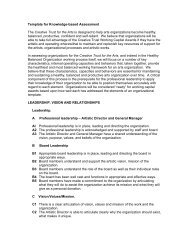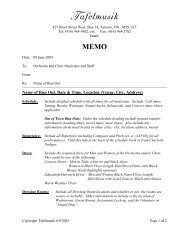20 Questions - Canadian Institute of Chartered Accountants
20 Questions - Canadian Institute of Chartered Accountants
20 Questions - Canadian Institute of Chartered Accountants
Create successful ePaper yourself
Turn your PDF publications into a flip-book with our unique Google optimized e-Paper software.
14. How will changes in programs<br />
and activities be coordinated?<br />
Changes to activities and programs need to be carefully coordinated across the<br />
organization to make sure they are supported with the appropriate resources. For<br />
example, setting up a new program may involve:<br />
• Recruiting new staff<br />
• Providing them with space for their work<br />
• Equipping them with computers, telephones, vehicles, tools, etc<br />
• Training staff and volunteers<br />
• Promoting the program with information in print (e.g. brochures) and<br />
electronic (web sites) format<br />
• Creating or adapting computer programs for recording participation, billing<br />
and payments<br />
These steps are relatively simple in smaller organizations where the work<br />
involved can be shared and coordinated informally. In larger organizations,<br />
however, a number <strong>of</strong> departments may need to recognize the needs <strong>of</strong> the new<br />
program in their operating plans and budgets. For example: The Information<br />
Services department may be expected to provide computers, s<strong>of</strong>tware, Internet<br />
service, telephones, s<strong>of</strong>tware training and technical support; the Facilities<br />
department may need to add or change work space and provide furniture and<br />
equipment; the department responsible for public inquiries and program registration<br />
may need training and new staff.<br />
Some organizations use staffing plans and budgets to coordinate and manage<br />
human resources.<br />
Organizations with experienced, sophisticated staff recognize the need for<br />
coordination in operational planning and day-to-day activities. In some cases,<br />
however, staff may be inexperienced or lack the resources to provide essential<br />
support. Boards should be aware <strong>of</strong> the importance <strong>of</strong> coordination and, where<br />
appropriate, ask management to explain how they handle it, particularly in<br />
terms <strong>of</strong> budgeting and resource allocation.<br />
Recommended practices<br />
• The plans <strong>of</strong> staff departments and volunteer committees are coordinated<br />
• The board considers the need for coordination in its review and approval <strong>of</strong><br />
the operating plan.<br />
15. What is the budget philosophy?<br />
A budget philosophy provides guidance to the people who prepare the budget<br />
and to the Board that approves it on such issues as:<br />
• The intended financial outcome – break-even, surplus or deficit<br />
• The approach to budgeting – conservative or aspirational<br />
Many not-for-pr<strong>of</strong>it organizations aim for at least a modest annual surplus (<strong>of</strong><br />
revenues over expenditures) to maintain and increase their financial strength<br />
and capacity to sustain their programs. In some cases, they may plan for a more<br />
substantial surplus to build up funds for future expansion or special projects.<br />
More rarely it may be appropriate to run a deficit (by paying out more than<br />
they take in) for one or more years.<br />
In approving budgets, the board must also be conscious <strong>of</strong> their fiduciary<br />
responsibility for the protection <strong>of</strong> the organization’s assets, and be satisfied that<br />
the budget is realistic and consistent with the organization’s tolerance for risk. A<br />
budget’s approach to risk can be “conservative” or “aspirational” – or something<br />
in between.<br />
Conservative budgeting emphasizes protection <strong>of</strong> the organization’s financial<br />
position. This is <strong>of</strong>ten done by using lower estimates for revenues and higher<br />
estimates <strong>of</strong> costs – a common practice in government budgeting. This<br />
approach tends to be favoured by organizations with a low tolerance for risk.<br />
Signs <strong>of</strong> over-conservatism include favourable budget variances during the year<br />
and a rush to spend money at the end <strong>of</strong> the year.<br />
Aspirational budgeting aims to inspire staff, volunteers and donors to achieve<br />
ambitious goals. This is done by setting high targets for revenues and lower cost<br />
estimates. The approach is attractive to organizations with a larger appetite for<br />
17












